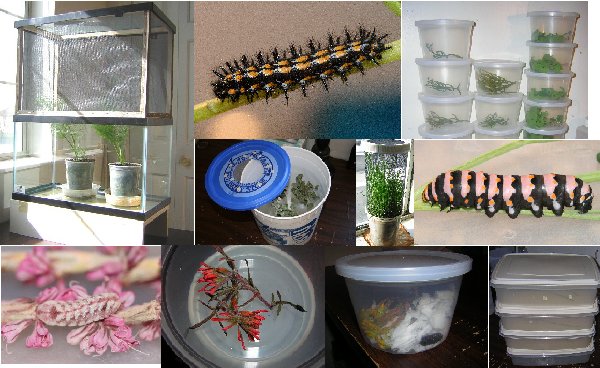Caterpillar Setups

There are a myriad of cages, containers, and strategies to raise butterflies indoors (usually preferrable over outdoors). Some work better than others and are usually specific to butterfly families, subfamilies or genera.
The picture galleries below both illustrates and explains these setups a little better. Always remember to keep cages and containers away from direct sunlight unless you are using live potted plants:
- Open Terrariums
- Semi-Closed Terrariums
- Collapsible Cages
- Open Buckets
- Closed Containers
- Potted Plants
- Sleeves
- Twin Cup Method
-
Open Terrariums (9)
The biggest enemy to butterfly caterpillars is their own waste or frass. It is important to provide sufficient airflow in open terrariums or open buckets to help caterpillar frass dry. It's also important to remove frass regularly. The advantage of terrariums over buckets is that it is easier to watch the caterpillars feed in a terrarium.
In a setup like this, it is important to place host plant cuttings in bottled of water, cork cuttings with facial tissue and place larvae on the host. Clean out frass regularly and replace host every five days or so.
Remember to keep open terrariums indoors and away from direct sunlight unless you are using potted plants with plenty of ventilation. -
Semi-Closed Terrariums (10)
High-humidity cages can spell doom for many species of butterflies whose caterpillars live in a relatively dry environment and can get sick. One major exception to this are the admirals and viceroys. They are accustomed to feeding in humid riparian areas (especially in the eastern U.S.). Raising admirals and viceroys in a terrarium with a glass lid makes sense because the caterpillars do NOT get sick in this environment (of course, you still need to change out plant and remove frass once a week) and willows and cottonwoods stay succulent in the high humidity.
The problem with not providing willows with high humidity is that they can dry up in less than an hour and freshly collected caterpillars can wander off! When you obtain willow cuttings, seek out relatively new growth; but cut out the terminal ends of branches with the newest growth. (Those can dry up anyway.) By exercising a little practice and patience with handling willow and cottonwood cuttings, you will find that it gets easier. -
Collapsible Cages (6)
Collapsible cages are ideal for when raising caterpillars either on potted plants or with host cuttings. When using potted plants indoors, place near a window to obtain filtered sunlight; watering the plant regularly.
When using cuttings indoors, keep away from direct sunlight and replace cuttings every three to four days consistent with quality of host. Remove caterpillar frass regularly.
These popup cages are easily sanitized with Lysol or bleach and can be collapsed for storage when not in use. It is easier to see through black cages than white cages in brighter or outdoor environments. Both can be ordered online.
Also, click here for more information on black vs. white cages.
-
Open Bucket (23)
Very similar to the open terrarium technique; but uses a less expensive five or six gallon bucket. Place plant cuttings in water bottle or similar. Cut hole around lid and place butterfly net material on top of bucket to keep predation away.
Open Buckets techniques work best when you use them indoors and away from direct sunlight. -
Closed Container (38)
Because caterpillars of some species of butterflies are cannibalistic, it becomes practical to rear them in separate containers such as storage containers, squat tubs, or restaurant supply condiment containers (i.e, solo cups.) Using closed containers is advantageous over using terrariums or buckets in that it lowers the setup time; but also is more time consuming because you generally need to change out caterpillar frass and host plant every day. -
Potted Plant (28)
Another alternative to changing out plant every 4-7 days is to simply pot the host plant and place a protective screen, cage, sleeve, or paint strainer around the plant. With this type of setup, all you need to do is place the plant adjacent to a suitable light source and water it. -
Netted sleeve (2)
Cuttings of some species of trees may not necessarily keep well in an open terrarium or open bucket type setup.
An alternative is to create a pull-string nylon net sleeve and place this around a branch with caterpillars. This also saves the time of cleaning out frass and changing out host plant cuttings.
The drawback to this technique is that spiders can smell caterpillar frass and still kill butterfly caterpillars if they are too close to the sleeve. Parasites are also a major concern. Make sure that the sleeve is completely secure from predators or parasites that can enter and kill your larvae. See this video. -
Twin Cup Method (21)
Caterpillars of some species of butterflies prefer to rest off the plant. Although natural in nature, this poses a problem with using an open terrarium or open bucket technique for these larvae because they keep crawling off the plant and can't crawl back because of the obstacle of the bottle holding the host plant cuttings. An alternative to this is the twin cup method. This fairly simple setup is explained in these two movies as well as the photos provided below. -
Closed Container - Papilio indra (7)
I use a closed container technique for Papilio indra larvae that are fourth or fifth instars whereas I use an open terrarium setup for smaller first through third instars. Papilio indra larvae can perish in the lab for several reasons. (See Utah Lepidopterist article). Using closed containers for indra swallowtails simply requires that you separate larvae into individual storage containers with a few small holes for ventilation, replace host plant cuttings and remove frass morning and evening. For most, this can be too tedious. It works for me because it produces healthy adult butterflies.
In addition to the slide show below, please click here to see a video presentation.


